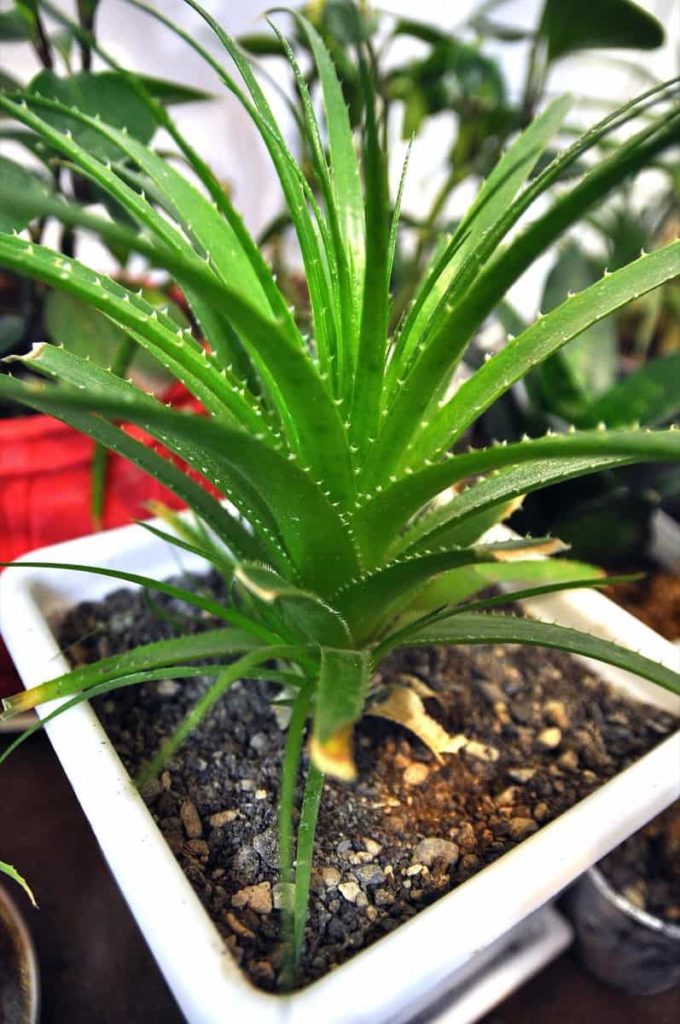Aloe is a great plant to keep on hand not only because of its unique appearance but also because of its multiple uses. Aloe Vera, a perennial in a hot climate, is relatively easy to grow indoors, outdoor although it needs strict: well-drained soil. Like other succulents like Cacti, Aloe Vera does not do well in a growing medium that holds water. Let’s check out how to prepare the soil for Aloe Vera plants.
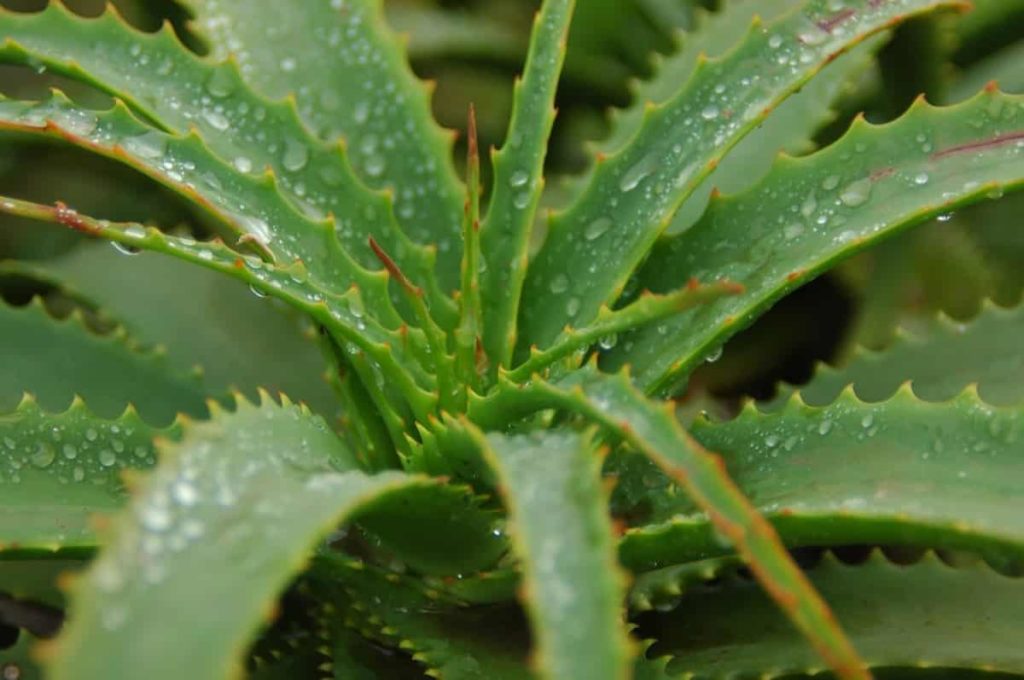
The best soil for the Aloe Vera is often sandy or has small rocks that allow water to exit the pot quickly. The best soil for the Aloe Vera resists compacting and has a light, fluffy structure that allows water to flow freely. To speed up good drainage using the right soil, plant the Aloe Vera in the right type of pot. An unglazed clay or a terra cotta pot often works best as they are material absorbers and help remove excess water from the soil.
The pot should also have drainage holes so the water will run out. For the best drainage, set the plant in the sink while watering, which will allow the excess water to move out and drain. The Aloe Vera plant roots like to dry a little between watering (but not entirely). Aloe Vera does well if the soil is a bit moisture retentive.
How to prepare the soil for Aloe Vera plants
Soil pH for Aloe Vera
Aloe Vera will usually grow well in soil with a pH that varies from 5.5 to 8.5 on a pH scale. Most succulent growing mixes will fall in the 5.5 to 8.5 pH range, but keep in mind that the soil’s pH changes when the plant is watered. Fortunately, tap water pH rarely creates a problem for the Aloe Vera as tap water pH ranges from 6.5 to 8.5. If dealing with an unhealthy Aloe plant consider collecting rainwater or giving filtered water to the plant.
Preparation of soil for Growing Aloe Vera on grounds
The Aloe Vera grows in all kinds of soils, but well-drained soil with high organic matter is most suitable. It grows well in bright sunlight. Shady conditions result in an attack of disease and are highly sensitive to water stagnation. Organic fertilizers such as farm yard manure, vermicompost, or green manure are preferred for Aloe Vera crops. The recommended dose of farm yard manure at the time of soil preparation is 10 to 15 tonnes per hectare. You should apply the same dose of farmyard manure every year.
In case you missed it: Growing Aloe Vera in Pots from Cuttings, Seed, Division
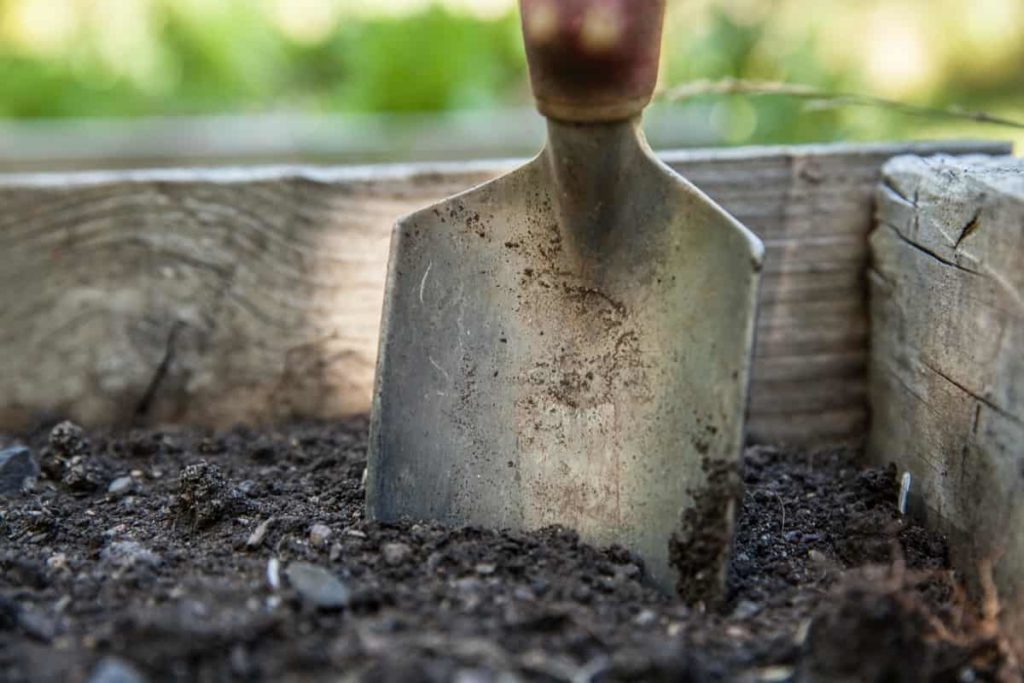
Preparation of soil for growing Aloe Vera in pots
Aloe Vera needs sandy or gravel soil with good drainage to reduce the risk of root rot and nutritional deficiency. When planted in containers, Aloe Vera plants perform well in a mix of commercial potting mix with extra sand, granite grit, or perlite. You can also plant them, especially in soil used for cactuses.
Regular watering will drain the nutrients out of the soil over time. So, additional nutrients from compost, well-rotted manure, or granular fertilizers should be part of your potting mix. Humus, compost, and commercial fertilizers all provide high-quality, available nutrients.
How to grow Aloe Vera in poor soil
The soil that drains very slowly will not sustain the Aloe plant. Amend by adding large soil particles, sand, and silt. Soil heavy in clay tends to maintain water and makes the wet soil environment unsuitable for Aloe Vera. Soil additions that improve soil drainage include perlite and vermiculite. While the Aloe Vera thrives in poor soil, it should be well-drained, or the plant will suffer. Modifying heavy clay soil with compost, perlite, or weathered pumice and sand.
Sandy soils have relatively low organic matter content, which may need to be modified from time to time. A balanced liquid fertilizer designed for blooming plants works best, although you can also use slow-release pellets. Avoid compost and other soil modifications with large quantities of organic material due to the tendency to increase moisture levels. Fertilize the Aloe Vera plants only in mid-spring and late summer, using a dilute solution. You can only repot the Aloe grown from the container can only be re-potted to refresh the soil instead of fertilizing.
In case you missed it: How to Prepare the Soil for Banana Plants: Best Soil Mix, pH, Compost, and Recipe
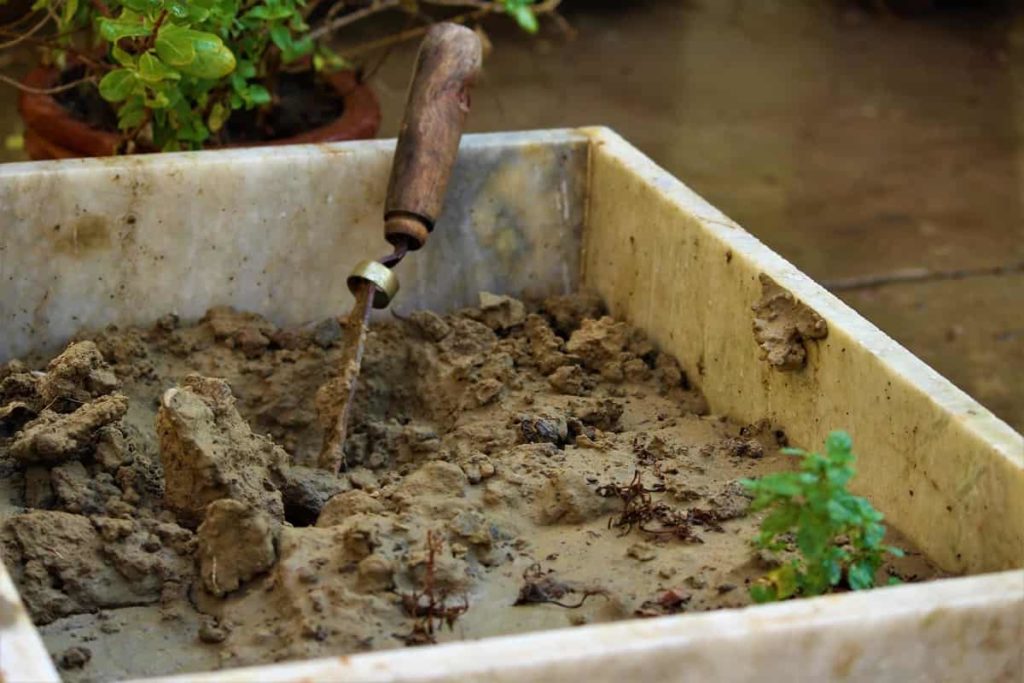
Symptoms of using the wrong soil
Aloe Vera is a much less caring plant. If you provide enough light and properly water it, you will be less likely to fail. If despite everything and you still ended up killing one, there’s probably something wrong with the soil you’re using. Yellowing of leaves when your mixture is bad can be caused by either lack of moisture or high salt buildup. But if the discolored leaves soon become soft and mushy, they can be brought in through poor drainage.
Like all plants, the Aloe needs water because its body composition is 99.5% water; the rest are solid materials. But as a succulent, it doesn’t require much water. Nutrition is also not much needed. You can apply a low-balance succulent diluted fertilizer once a year, and you are good to go. Aloe plants don’t like to sit in water because they can’t work well and become more susceptible to fungal and bacterial infections.
Soil composting for Aloe Vera
Soil amendments are significant in the case of Aloe Vera, as succulent plants can grow very slowly without proper nutrition. When the last plowing, add well-decomposed cow dung to the soil. In containers, it is better to choose succulent fertilizer for Aloe Vera. These mixes will contain good soil extraction and nutrients that Aloe Vera needs. When it is time to plant, make a 50/50 mix with compost and potting mix.
In case you missed it: How to Prepare the Soil for Banana Plants: Best Soil Mix, pH, Compost, and Recipe
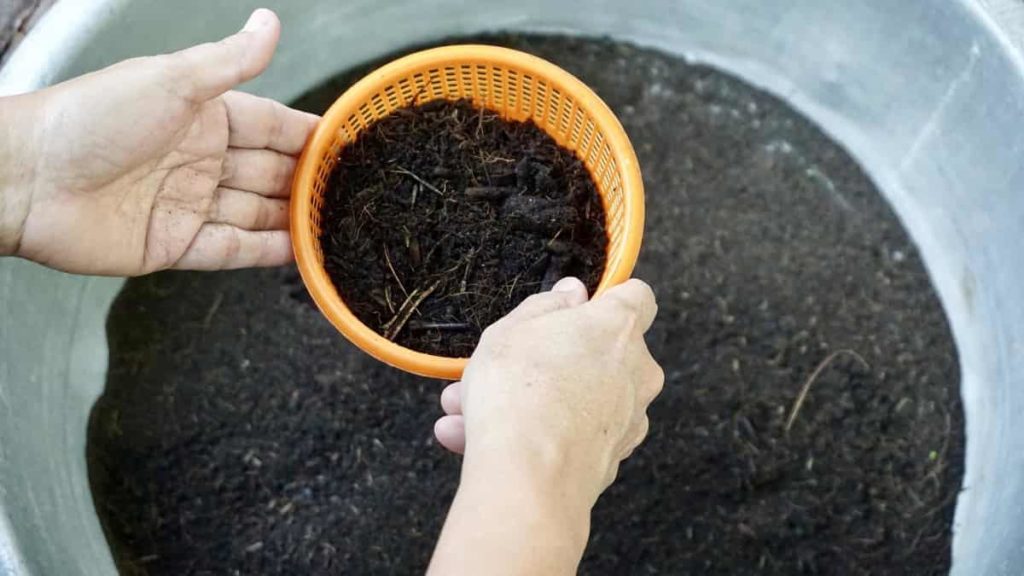
Depending on the potting mix, you may need to add sand or perlite. You can also mix your Aloe Vera pots with granite or chicken grits to balance soil temperature and prevent insects from laying eggs in pots. Most importantly, do not use organic matter to mulch containers, as it can cause more water to remain, causing your Aloe Vera roots to rot.
Land preparation for Aloe Vera
Aloe Vera grows in different soil types as long as they have good drainage. For Aloe Vera, soil can range from sandy loam to sandy soil, while pebbles, especially in the medium soil structure, positively impact cultivation. Whether the soil is deep or not is of little importance because the Aloe Vera has a surface root system and can only go deep in dry conditions. But it is not recommended to plant Aloe Vera without a permanent irrigation system.
Organic material in soil is important that in its absence, the Aloe Vera is not specifically for biological cultivation. The ground should be well plowed to bring the ground to a fine tilth stage. To increase soil fertility, add about 15 to 20 tons of well-rotten farmyard manure during the last plow. You should form ridges and furrows at a distance of 40 centimeters. Suckers should be planted at a distance of 40 centimeters. The roots of the Aloe Vera did not enter below 20 to 30 centimeters, so plow the grounds well in terms of soil type and bring the soil into the fine tilth.
Best soil mix for Aloe Vera
The best Aloe Vera potting soil is a mixture of sand, perlite, pumice, and pine bark. Aloe Vera prefers neutral over alkaline pH from 7.0 to 8.5 but can tolerate slightly acidic soil. Combine One part Loam, one part sand, one part pumice, 1 part perlite, and one handful of pine bark fines in a large container., you may want to add a little water when mixing to mix the ingredients, but be careful not to have much water. Always make a mistake on the dry side while potting soil for Aloe Vera plants.
In case you missed it: Best Fertilizer for Avocado: Homemade, Organic, Natural, Liquid, Compost Manure, NPK, and Schedule
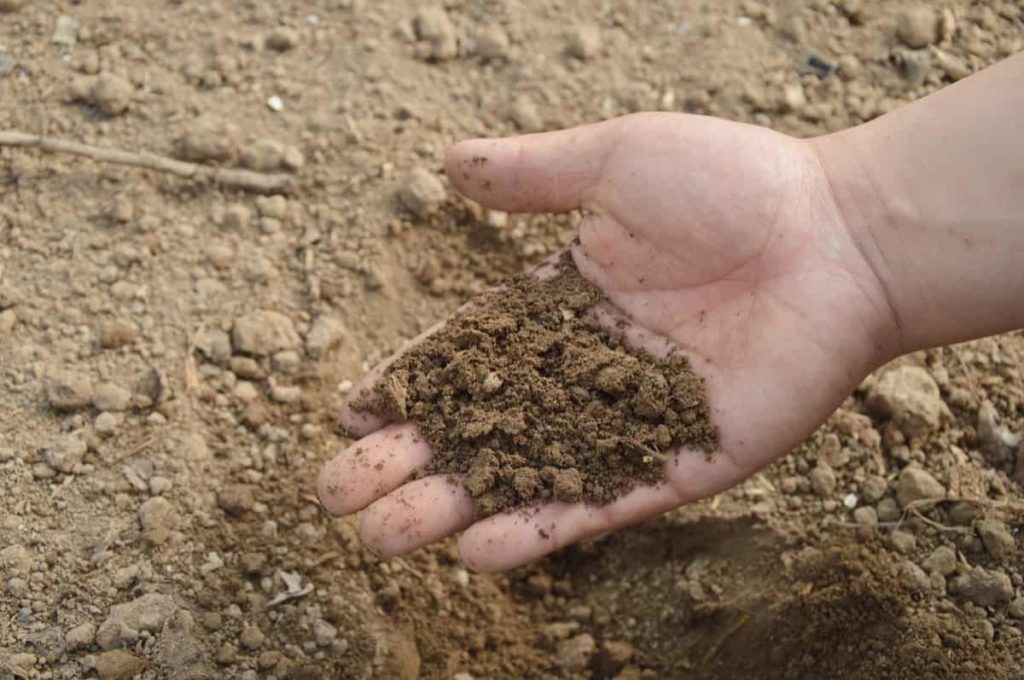
The best soil for Aloe Vera contains ingredients that do not contain water, such as gravel and sand.
- Pumice – Pumice is a porous, light volcanic rock that adds structural integrity to the growing mix and drains well.
- Perlite – Perlite prevents the soil from compressing, but it absorbs a small amount of water and then releases it slowly.
- Chunks of bark –Chunks of bark are often used as a primary ingredient in soil suitable for growing Aloe Vera.
- Lava rocks – Lava rocks, another volcanic rock, add stability to the soil and drain well.
- Peat moss – Peat moss can be added to some mixes but usually in small quantities because it retains some water.
- Fertilizer – Fertilizer is added to the mix to encourage the growth of plants. Feeding the Aloe Vera plant will not be necessary for 1 to 3 months if this mixture contains fertilizer products.
- Coconut coir – Coconut coir prevents soil from compressing.
Soil recipe for Aloe Vera
For proper drainage, the potting mix should contain at least 50% coarse inorganic materials such as washed construction sand or pumice. Organic matter and absorbent soil amendments should make the remaining 50 percent to ensure enough water is left in the soil to allow nutrient absorption.
Mix 2 portions of washed construction sand or pumice, 1 part manure or compost, and 1 part chopped leaves, bark, or other organic matter. To ensure a continuous supply of nutrients, fertilize regularly or plan to repot your Aloe Vera for two years from each year.
Natural soil amendments for Aloe Vera
Egg shells will even give you an additional promotion of potassium to your Aloe Vera plants. You can crush the shell and mix it with soil. Soak in a cup of water overnight, make eggshell tea from it, and then sift out the shells the following day. Next, cut the Banana peels and mix them with your soil, then let it start your natural decomposition process. Finally, you can apply coconut oil to Aloe Vera to suppress any insects that are hibernating in your plant during winter, and it mainly suppresses the invading bugs.
If you have discovered some insects in your soil and are unsure what they are, you can apply coconut oil. You can dissolve Epsom salt a little in some water, so feed it your Aloe Vera; it’s full of essential minerals that will help your plant thrive. Don’t go overdone even if nothing is too good, especially for the Aloe Vera plants because they are not heavy feeders.
What to do with soil when growing Aloe Vera
Aloe Vera does not attract many insects as other herbs do, so the main advantage of growing it with other herbs is to repel harmful insects. The Aloe Vera is completely harmless to other plants as well. You don’t have to think twice before putting it in your garden. But it’s drought-loving, so make sure to grow it with herbs with the same water needs. Strawberry plants, Sow Thistle, Onions, Balm of Gilead, Scented Geraniums, and Borage plants like to grow with Aloe Vera plants on the outside.
In case you missed it: How to Prepare the Soil for Pomegranate Plants/Trees: Best Soil Mixture, Ph, and Compost
Planting companions together has mutual benefits. They can easily improve plant growth by preventing pest problems, improving soil fertility, and accelerating growth. The Agave is great for xeriscaping because they have long, narrow leaves. An Agave pairing with Aloe Vera is a great way to add color and texture without worrying about both plants. Elderberry and Aloe Vera plant flowers look great together. Also, they are both very strict and will survive winter if planted outside.
The Borage has soft blue leaves and beautiful star-shaped flowers that attract flies. Borage will not tolerate drought, so be sure to provide regular water if you choose to grow it with other succulents. Sow Thistle is a soft blue color and can be too tall. It’s great to attract bees, so planting Aloe Vera would be a good choice for attracting bees.
Scented Geraniums are well-shaped plants that offer a wide range of colors. You can easily take care of it; both are drought and heat tolerant. Aeoniums have thick, spoon-like leaves. This makes them great for planting with Aloe Vera plants as they prevent the Aloe Vera from becoming sunburned.
Conclusion
Soil is an important part of successful agriculture and the real source of nutrients that we use to grow crops. Aloe Vera plant is one of the best plants you can grow at home either indoors or in your yard. The Aloe plant not only has some great healing properties, but it is also quite easy to grow with a little help from direct sunlight or light. In this article, we have mentioned all the important things of soil for Aloe Vera. So, if you choose to plant Aloe Vera, make sure you check this article, which is a guide on soil preparation for Aloe Vera plants.
- How to Grow Hibiscus from Flower
- Plantation Ideas for Home Decoration: A Beginners Guide
- Flower Garden Designs and Layouts for Beginners
- Planting and Spacing Techniques in Papaya: A Beginner’s Guide
- Growing Gold: Essential Techniques for Planting Pineapples
- How to Make Kalanchoe Plant Bushy: Home Remedies and Solutions
- 11 Reasons Why Your Gardenia is Not Blooming: Home Remedies and Solutions
- Eco Elegance: The Guide to Designing a Drought-Tolerant Landscape
- Gardening on a Slope: Strategies for Hillside Landscaping
- Nourish and Flourish: Top Organic Mulches for Thriving House Plants
- Everything You Want to Know about Indian Mogra Flower: Discover Uses and Growing
- Green Thumb Success: Expert Tips for Cultivating Greenhouse Pumpkins All Year Round
- Maximize Growth & Flavor: The Ultimate Guide to Companion Planting in Herb Gardens
- How to Control Rhododendron Problems Naturally: Home Remedies and Organic Ways to Fix Them
- Natural Magic: The Remarkable Benefits of Cinnamon for Plants
- Best Steps to Revive Dying Tulip with Natural and Organic Treatment
- 10 Reasons Why Your Angel Trumpet is Not Blooming: Remedies and Treatment
- How to Fix Periwinkle Leaf and Flower-Related Problems: Natural Remedies and Solutions
- How to Fix Zinnias Leaf and Flower Problems: Discover Natural and Home Remedies
- Organic Steps to Induce Lemon Tree Flowers: A Comprehensive Guide
- Bloom Booster: Crafting the Perfect Homemade Bougainvillea Fertilizer
- Optimizing Growth: A Guide to Applying NPK Fertilizer for Potted Plants
- 10 Best Homemade Fertilizers for Rubber Plant: DIY Recipes and Application Method
- How to Boost Female Pumpkin Flowers: Effective Steps for More Flowers and High Yields
- Transform Your Indoor Garden: Top Benefits of Pink Salt for Houseplants
- 10 Best Homemade Fertilizers for Peacock Plants (Calathea): Easy DIY Guide
- Unlock Blooms: 9 Reasons Why Your Potted Chrysanthemum is Not Blooming
- 8 Reasons Why Your Potted Hibiscus is Not Blooming: Fix it with Simple Solutions
- Unlock Blooms: 9 Key Reasons Your Potted Frangipani Won’t Flower
- 10 Reasons Why Is My Ice Plant Not Blooming: Remedies and Treatment
- 10 Reasons Why My Potted Hydrangea Not Blooming: Treatment and Remedies
- 10 Reasons Why is My Wisteria Not Blooming: Remedies and Treatment
- 10 Reasons Why is My Goldfish Plant Not Blooming: Remedies and Treatment
- Maximize Your Space: Ultimate Guide to Balcony Gardening with Grow Bags
- 10 Reasons Why Your Iris is Not Blooming: Remedies and Treatment
- 10 Reasons Why Your Anthurium Plant is Not Blooming: Treatment and Remedies
